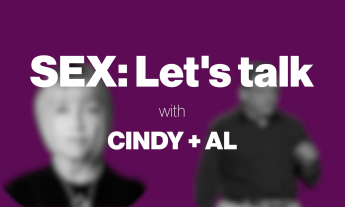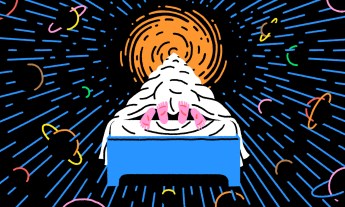
Many young people turn to pornography for information and advice. With this reality comes an opportunity: We can utilize it to start important conversations with them about sex and relationships, says public health researcher Emily Rothman.
With pornography and teenagers, conventional wisdom suggests the two be kept as far apart as possible. But this eye-opening statistic could make most people rethink the feasibility or wisdom of such an approach: According to a group of young adults surveyed for one study, 93 percent of males and 62 percent of females had viewed porn at least once before their first year of college. Other researchers have found that for many teens, porn is their #1 source of information about sex.
Given porn’s pervasiveness and its influence, could it also be used as a teaching tool? That’s the aim of an innovative “pornography literacy” curriculum created by public-health researcher Emily Rothman and collaborators Nicole Daley and Jessica Alder.
Seven years ago, Rothman, a professor of community health science at Boston University, came up with the concept. She was speaking with high school students about the causes of dating violence. As she talked about her career in public health, she noticed students’ eyes glazing over — until she said the word “pornography.” She recalls, “All of a sudden, that room full of high school students exploded into laughter and high-fives. I think there were some loud hooting noises.”
That moment led Rothman to an epiphany: Teens are interested in porn, they’re watching it, and they’re turning to it for answers about sex. She asked herself, “What if we could use the topic as a springboard for engaging them and talking to them about healthy relationships and sexual consent?” That’s when she started to think about the idea of pornography literacy.
“Media literacy” is a term that refers to the ability to think about print, video and internet messages in a specific subject area and reflect on how these messages are produced and consumed. Media literacy interventions have already been used to guide discussions with young people about topics such as tobacco and alcohol use, and eating disorders.
For their pornography literacy curriculum, Rothman, Daley and Alder designed a five-session weekly course. Among the subjects covered were the history of sexually explicit images, the unrealistic representations of sex in pornography, the link between pornography and sexual exploitation, and the impact of non-consensual pornographic images, such as sharing a person’s naked selfies. Each session was 90 to 120 minutes long, and together, they aimed to provide students with, as Rothman puts it, “tools for critical analysis that would enable them to make selections about pornography that were consistent with their values.”
In the course, “we did not show porn to the students or ask them to analyze pornographic scenes at any point,” stresses Rothman. Instead, “we used the concept of pornography in order to have deeper conversations.” She and the other researchers found that teens believed a number of erroneous or distorted ideas from their porn consumption, and that the course proved effective at dispelling many of them.
Here’s a look at some of the myths and misconceptions that things that teens hold about porn and sex in general:
Misconception #1: Pornography is a lucrative and high-profile career.
“A number of students went into the course thinking it might be glamorous to be a porn star,” says Rothman. “They thought it was a really quick route to being rich, famous and popular and to being an influencer on social media. They got a reality check about that.”
Just as Rothman doesn’t support forbidding teens to watch porn, she also doesn’t believe in scaring them away from pornography as a profession. However, she and her colleagues want teens to look at the occupation in an informed way. “We are not fearmongers, but we want teens to think about all the possibilities before you decide this is a situation to put yourself in,” she explains. “It’s not an easy life, and it comes with dangers — you can be vulnerable, you can be exploited, and you can be sexually assaulted.”
Misconception #2: Porn gives you how-to instruction in sex.
Many professional porn videos are big productions. They’re filmed with a whole cast and crew — directors, actors, sets, scripts, sound effects, cameras, lighting, hair stylists, makeup artists, and more. However, according to Rothman, “students in the class would say, ‘I turned to porn for information.’ They’d look at it because they wanted to be considered good at sex, impress their partners, and act like they knew what they were doing.” She adds, “That’s the part I worry about because pornography is a big act — it’s designed to be entertainment, not a documentary or instruction manual.”
While disheartening, it’s not surprising that teens are looking at porn for advice. Many young people don’t have reliable sources of information about sex — only 50 percent of states in the US require schools to have any kind of sex education program, and fewer than half of the states requiring that material in it be medically accurate. Porn, on the other hand, is accessible to anyone with a laptop or phone, and there’s an endless supply of videos to watch.
One of the goals of the pornography literacy curriculum was to expose the artifice behind porn, and it was able to make a real difference there. The researchers polled students about their attitudes before and after taking the course, and afterward, according to a paper published in the American Journal of Sexuality Education, “At post-test, participants were less likely to agree that … pornography is a good way for young people to learn about sex.”
Misconception #3: According to porn, there’s no need to communicate clearly or ask for permission in sex.
Often in porn, actors behave aggressively towards each other without checking if it’s OK. This can lead some teens to think it’s fine to act this way in real life. Not true, said the instructors. “If you’re not seeing it on camera, then you may think you don’t have to ask permission before you try some of that stuff,” explains Rothman. “And you definitely do.” She adds, “What you don’t see in pornography is excellent communication between partners, but you have to have excellent communication skills and long conversations with your partner.”
The instructors acknowledged to their students that talking about these things can be awkward and difficult, but these discussions are necessary in healthy, respectful relationships. The bottom line: “If you’re not ready to have that conversation verbally, you shouldn’t be trying it sexually,” says Rothman.
Misconception #4: With sex, it’s normal for men to be more dominant and for women to be more submissive.
The instructors used porn to prompt students to think about the bigger narrative being put forth in many videos. They asked teens to consider this question: “Number one: ‘Who’s in charge?’” Rothman explains, “We happen to know the majority of porn features and shows men taking control of the situation and women being subservient. We ask them to think about that: ‘What does that mean? Why would this be? Is this fair?’”
Other things they ask teens to reflect on: “What kind of conversation is there about what’s going to happen next? When does the sexual encounter end? Who gets to decide that it’s over? Often, it ends when a man has an orgasm — what do you think about that?”
Misconception #5: Sending and receiving nude pictures of other teens is no big deal.
“A lot of kids are surprised to find out if you’re under 18 and you take a naked selfie and send it to your partner who’s also under 18, you’ve both disseminated child pornography,” says Rothman. “That’s illegal in the US.” (Specifically, the sender would be guilty of disseminating child pornography; the receiver, of possessing child pornography.) But what if you wanted to send the selfie? “It doesn’t matter — if you’re under the age of 18, it’s still counts as illegal,” she adds. More and more states are taking this kind of activity seriously, and lawmakers are developing statutes that make this punishable by law.
The curriculum also aimed to get teens to rethink another common activity: Sharing someone’s naked selfies with other people. “This is non-consensual sexual behavior, and it’s on the same level as other types of sexual assault,” says Rothman. “It’s not an innocent ‘Haha, I’m just showing my buddy this photo.’ It’s violating someone, and we laid it out like that. It can be sobering for a lot of kids, and I think it sticks with them.”
So far, the pornography literacy course has been taught twice in the Boston area as a pilot. After a successful test run, Rothman and her colleagues are now looking to partner with schools and organizations to roll out the curriculum elsewhere and study its effects on outcomes such as dating abuse and violence. They’re also exploring effective ways that parents can talk to their kids about porn. (Rothman is also developing healthy relationship classes for teens with autism.)
“If there was a group of happy, healthy teenagers who’ve never seen porn, I wouldn’t argue that it’s important for them to know it,” says Rothman. “But living in today’s world, the odds that they’re going to see it are high so we should address it.”
Watch her TEDMED Talk now:

















